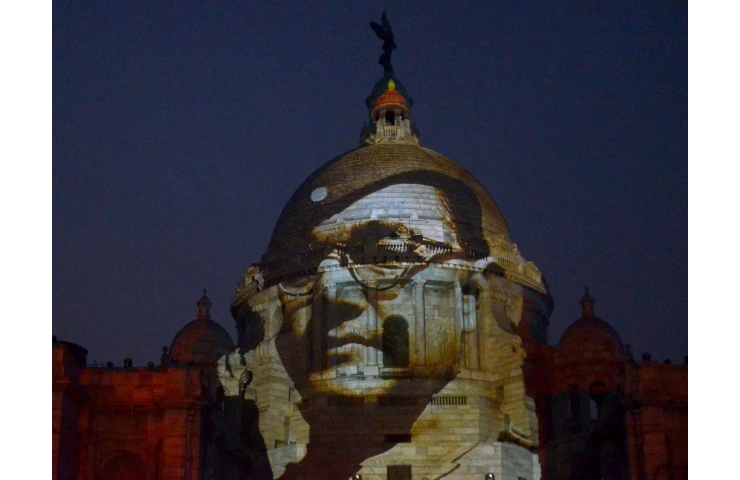Netaji Subhash Chandra Bose is a legend in Southeast Asia, not just among the Indian diaspora, but also amongst others in the region, particularly in Malaysia, Singapore and Burma, currently known as Myanmar. Symbolic of this was the trend of naming the children of all races in Southeast Asia born during the period and named after Subhas, who is more famous in the region as Chandra Bose.
Netaji was not the founder of the Indian National Army, even though the INA and Subhash are almost synonymous. The INA was an armed force formed by Indian nationalists in 1942 through patronage of the Imperial Japanese Army to secure the independence of India. During World War II, Japan invaded Southeast in 1942. At the time, 70,000 Indian troops stationed in the region, most of them along the Malayan coast.
Till the grand statue of Netaji Bose is completed, a hologram statue of his would be present at the same place. I will unveil the hologram statue on 23rd January, Netaji’s birth anniversary. pic.twitter.com/jsxFJwEkSJ
— Narendra Modi (@narendramodi) January 21, 2022
Both Malaya and Singapore fell to the Japanese and in the Singapore campaign alone, 45,000 Indian prisoners of war (POW) were captured. It was from these POWs that the Japanese decided to create an artillery army which would fight against the British. The first INA was formed under Mohan Singh, a former officer of the British Indian Army and captured during the Malayan campaign. Conditions in the PWO camp as well as resentment against the British in general, saw many POW volunteers to join the INA which received considerable support from the Japanese Army and also from the ethnic Indian population of Southeast Asia. However, disagreement between Mohan Singh and the Japanese Army command regarding the autonomy of the INA led to the disbandment of the first INA in December 1942.
Even though Mohan Singh alienated the Japanese through his insistence on the autonomy of the INA from the Japanese, the latter eventually relented to form the second INA. Mohan Singh himself recommended Chandra Bose for the leadership of this revitalised INA.
Bose’s reputation as a fervent nationalist, who had given a slip to the British from confinement and fled to Germany via many countries in between, was already known to the Indian diaspora as well as the Imperial Japanese Army, who were quite open to the idea of a nationalist army led by Bose. Subhash arrived in Singapore in July 1943 to take command of what came to be known as the second INA, now rechristened as AZAD Hind Fauz (AHF). It was only after Subhash joined, thousands of volunteers were looking to join the AHF.

Image tweeted by Prime Minister Narendra Modi (Photo: ANI)
Even though the AHF was subordinate to the Japanese Army, Subhas found it acceptable for freeing India from the colonial rule of the British Empire. For Subhash, freedom of India was more precious than Japanese imperialism. Even though he did not succeed in defeating the British Army through the Imphal campaign and many of his soldiers and lieutenants perished, the process that was set in the by AHF led to conditions that eventually forced the British to quit India and grant us independence.
The decision of the present government to install Subhas’ statue at the War Memorial in the India Gate is a fitting tribute to the role played by him in India’s freedom struggle.
Subhas’ role in India’s freedom struggle is well-known to the Indian public and the world at large, but the impact that he made in Southeast through the INA and the AHF is less known to most Indians. Through the AHF, which he led and directed, he instilled among the Indian diaspora who were otherwise timid and docile, a great sense of nationalism and fighting spirit. Participation in the nationalist struggle invested Southeast Asian Indians with a rare sense of dignity and helped fostering a mushrooming of militant trade unions making it difficult for the returning British planters to perpetuate their control over what had been a docile force.
Interview with MJ Akbar on the enigma that Subhash Chandra Bose continues to be
Through his inspiring speeches in the football ground of Seremban, a small town about 50 miles away from Kuala Lumpur, centre of rubber plantations, Subhash made the people conscious of their rights and solely responsible for the growth of trade unions in pre-independent Malaya.
Old Indians in Seremban who are still alive and were children during Netaji’s visit to the town still salute the ground from the ramparts of where Netaji spoke. No other Indian nationalist was able to give that sense of patriotism and dignity to the local Indians, many of whom contributed to the growth of Indian nationalism and to the cause of India’s freedom.
Subhash was a pan-Asianist and believed Indian freedom struggle intrinsically linked with the liberation struggle of Asia
The INA’s Rani of Jhansi movement proved to be a pioneering effort at drawing Southeast Asian Indian women out of their traditional roles and expectations. It inspired some of them to take up mainstream roles for the cause of equality and emancipation. It was self-discovery for many of them and brought them into public life in different professions and contributed to the national efforts. Chandra Bose’s name was instilled in the minds and hearts of the Indian diaspora in Southeast Asia.
Places associated with Netaji Subhas Chandra Bose to be promoted as tourist destinations
(Baladas Ghoshal is a former Professor and Chair in Southeast Asian Studies, Jawaharlal Nehru University & Secretary general, Society for Indian Ocean Studies)




















